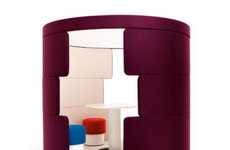
Pollen Robots
References: asahi & pinktentacle
If you've ever had the misfortune of suffering from hayfever, you know those afflicted will no just about anything to avoid the frustratingly uncomfortable symptoms.
Pod-shaped Pollen Robot are being sent out by a Tokyo weather forecasting company to monitor the levels of allergen-causing particles in the air. Their illuminated eyes may look a little creepy, but if they're capable of doing what they promise, they could become a hayfever sufferers best friend. 200 are being sent to volunteers who have been asked to hang the pods outside their doors this spring.
Their eerie eyes do more than add character to the 1 kg, 30 centimeter orbs. The colour they radiate indicates the intensity of the spores in the air, such as the concentration of pollens from Japanese cedar and cypresses. Colour variations include white, blue, green, red and purple.
Every minute, the Pollen Robots will send out their collected data by an internet signal which communicates directly with Weathernews in Tokyo where it will be processed and the details conveyed on an online map.
Pod-shaped Pollen Robot are being sent out by a Tokyo weather forecasting company to monitor the levels of allergen-causing particles in the air. Their illuminated eyes may look a little creepy, but if they're capable of doing what they promise, they could become a hayfever sufferers best friend. 200 are being sent to volunteers who have been asked to hang the pods outside their doors this spring.
Their eerie eyes do more than add character to the 1 kg, 30 centimeter orbs. The colour they radiate indicates the intensity of the spores in the air, such as the concentration of pollens from Japanese cedar and cypresses. Colour variations include white, blue, green, red and purple.
Every minute, the Pollen Robots will send out their collected data by an internet signal which communicates directly with Weathernews in Tokyo where it will be processed and the details conveyed on an online map.
Trend Themes
1. Pollen Monitoring Technology - Developing technology to monitor the levels of allergen-causing particles in the air has the potential to revolutionize allergy treatment and management.
2. Internet of Things Devices for Health - The integration of internet of things devices for allergy management provides a new path to remotely monitor and treat symptoms.
3. Data-driven Allergy Prevention - The use of data analytics to identify high-allergy areas and to better understand how environmental factors affect allergies can lead to more effective prevention and treatment options.
Industry Implications
1. Healthcare - Healthcare providers can incorporate pollen-monitoring technology and internet of things devices into their allergy management strategies.
2. Technology - Technology leaders can develop and market new pollen-monitoring devices to improve allergy management and prevention.
3. Environmental Science - Environmental scientists can analyze data collected by pollen-monitoring devices to better understand the factors contributing to allergy symptoms and find ways to mitigate them.
2.9
Score
Popularity
Activity
Freshness























